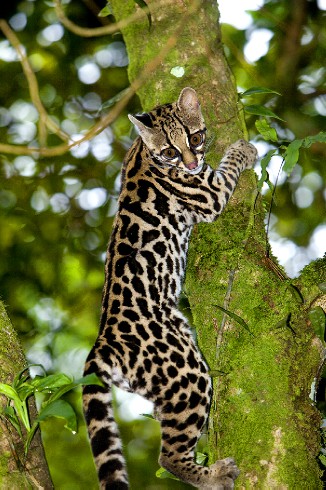Thursday, January 14, 2016 | By: Jim Zuckerman

I captured this margay in a Costa Rican jungle, and it was very dark. Plus, the background was much brighter than the cat. The only way to photograph this with good results was to use fill flash. I always hesitate to do that with wildlife because of the artificial look. Stiil, there was no choice. To make sure I got exactly what I wanted, I used manual exposure mode on the camera and the automatic mode on the flash. With this kind of lighting, there are two exposures: one for the ambient light (the background trees in this case), and the other for the foreground subject. They are independent of each other. First I take the ambient light reading, set the shutter and aperture, and then put the flash on ETTL. If the foreground subject ends up too light or too dark, I use the flash exposure compensation feature to correct it. In this way, you can get perfectly exposed images.
3 Comments
Jan 17, 2016, 1:28:24 PM
Bob Vestal - Thanks, Jim. I like your advice here. Definitely a different point of view that that of some wildlife photographers whose names you probably know. Let's talk more about situations where fill flash is helpful in nature photography and when you use Better Beamer...Best, B
Jan 15, 2016, 7:49:52 AM
Jim - Hi Bob, I have used the Better Beamer, but never for wildlife. I don't like adding artificial catchlights when shooting nature outdoors. The only creatures that have light emanating from their eyes live on the planet Zorgon somewhere deep in the Pleiades star cluster. Earth bound creatures only reflect their surroundings in their eyes. Besides, if the subject is so far away that a Better Beamer is needed, they will most likely be too small in the frame. At 800 ISO, an unassisted flash reaches very far.
Jan 15, 2016, 1:09:10 AM
Bob Vestal - Hi Jim - As usual, very helpful. Some wildlife photographers use Better Beamers with Fresnel lens to provide fill light, add catch light, etc, especially when photographing birds, but also larger animals--even at up to 100 feet or perhaps more.. Argument against this is potential harm to subjects (bright light in their eyes, which might temporarily blind or reduce visual acuity) and also might be alarming. I am wondering whether you have experience with this technique and/or your comments. Thank you, Bob.